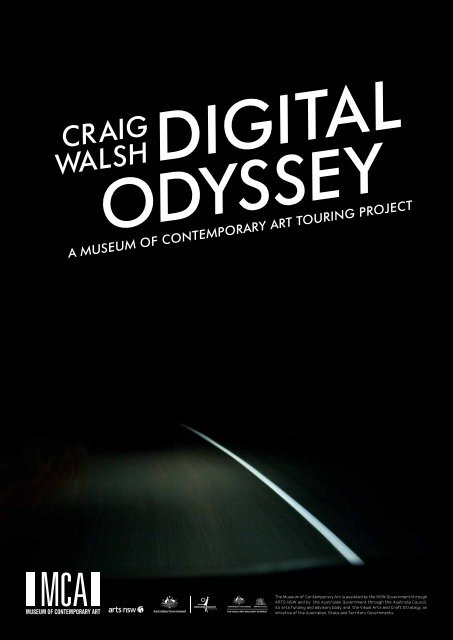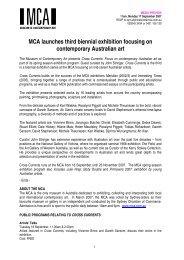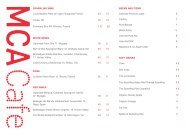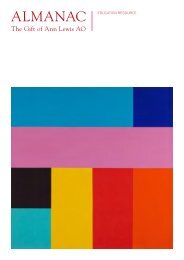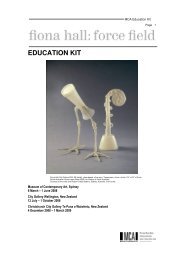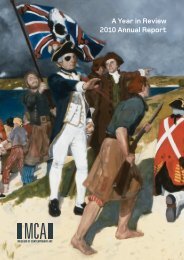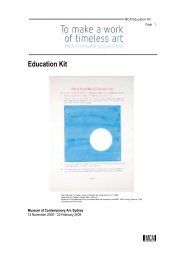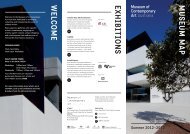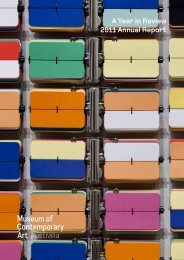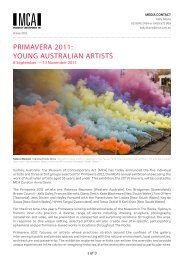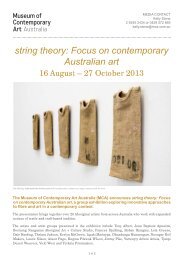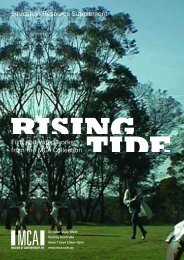Digital Odyssey - Education Kit - Museum of Contemporary Art
Digital Odyssey - Education Kit - Museum of Contemporary Art
Digital Odyssey - Education Kit - Museum of Contemporary Art
Create successful ePaper yourself
Turn your PDF publications into a flip-book with our unique Google optimized e-Paper software.
1<br />
The <strong>Museum</strong> <strong>of</strong> <strong>Contemporary</strong> <strong>Art</strong> is assisted by the NSW Government through<br />
ARTS NSW and by the Australian Government through the Australia Council,<br />
its arts funding and advisory body, and the Visual <strong>Art</strong>s and Craft Strategy, an<br />
initiative <strong>of</strong> the Australian, State and Territory Governments.
Contents<br />
Teachers’ notes – The purpose <strong>of</strong> this kit<br />
Curriculum connections p.3<br />
Craig Walsh – Biography p.4<br />
<strong>Digital</strong> <strong>Odyssey</strong> – Project description p.5<br />
Hiromi Tango – <strong>Art</strong>istic practice p.6<br />
Itinerary p.7<br />
<strong>Art</strong>istic practice p.8<br />
Major works p.9<br />
Humanature p.10<br />
Cross-Reference p.11<br />
Incursion p.12<br />
Classification Pending p.13<br />
<strong>Art</strong>efact H10515 p.14<br />
Primary Learning Activities p.16<br />
Secondary Learning Activities p.17<br />
Glossary p.18<br />
References p.19<br />
Acknowledgements p.20<br />
Front cover: Image courtesy and © Adam Murakami<br />
2
Teachers’ notes – The purpose <strong>of</strong> this kit<br />
This is a comprehensive resource produced for teachers and students by the <strong>Museum</strong> <strong>of</strong> <strong>Contemporary</strong><br />
<strong>Art</strong>, Sydney in conjunction with the project Craig Walsh: <strong>Digital</strong> <strong>Odyssey</strong>. The resource is designed for<br />
teaching and research purposes, and provides discussion and analysis <strong>of</strong> this national project, with links<br />
to the curriculum. The resource may also be used in relation to other subject areas, in particular Design<br />
and Technology, Human Society and its Environments (HSIE Science) and Science.<br />
The resource includes background information on Craig Walsh’s artistic practice, as well as discussion <strong>of</strong><br />
new media arts in general.<br />
Words in bold are defined in the Glossary at the end, and a list <strong>of</strong> references is also included for further study.<br />
This <strong>Digital</strong> <strong>Odyssey</strong> <strong>Education</strong> Resource will be frequently updated with images and information about<br />
Walsh’s journey, providing details <strong>of</strong> individual presentations <strong>of</strong> the project and new artworks.<br />
Get involved! Stay updated!<br />
Track where Craig is today. Read the <strong>Digital</strong> <strong>Odyssey</strong> blog. See picture <strong>of</strong> the latest artworks. Find information on current<br />
events. Do it all at digitalodyssey.com.au<br />
Curriculum connections<br />
Visual <strong>Art</strong>s/Creative <strong>Art</strong>s<br />
• <strong>Contemporary</strong> Australian <strong>Art</strong><br />
• The role <strong>of</strong> the contemporary museum<br />
• <strong>Art</strong> history<br />
• The frames<br />
• The conceptual framework<br />
• <strong>Art</strong>ist’s practice<br />
• Body <strong>of</strong> work<br />
• Tracing the career <strong>of</strong> artists<br />
• Diversity <strong>of</strong> media and practice<br />
English<br />
• Analysing visual texts<br />
• Oral and research skills<br />
• Creative writing<br />
• Critical essays and reviews<br />
Photographic and <strong>Digital</strong> Media<br />
• The moving image – video and installation<br />
Society and Environment<br />
• Visual arts as a reflection <strong>of</strong> contemporary<br />
culture<br />
• The influence <strong>of</strong> history on creative practice<br />
• Visual arts as a reflection <strong>of</strong> cultural and<br />
personal identity<br />
Science, Design and Technology<br />
• Advances in computer technology and its<br />
application to art<br />
• <strong>Digital</strong> s<strong>of</strong>tware programs<br />
• Architecture model design and construction<br />
ESL/NESB/CALD<br />
• Developing a visual arts vocabulary<br />
• Oral and written responses<br />
• Cultural identity and other issues in the visual arts<br />
3
Craig Walsh – Biography<br />
Craig Walsh is one <strong>of</strong> Australia’s most prominent<br />
artists, recognised internationally for his artwork that<br />
experiments with cutting edge digital technologies,<br />
site-specific projects and the exploration <strong>of</strong> alternative<br />
contexts for contemporary art. He was born in<br />
Orange, NSW in 1966, and was recently based in<br />
Brisbane, Queensland.<br />
His work has been shown in a number <strong>of</strong> national and<br />
international exhibitions, including the Jakarta Biennale<br />
XIII, Indonesia, 01SJ Biennal San Jose, California;<br />
<strong>Museum</strong> <strong>of</strong> <strong>Contemporary</strong> <strong>Art</strong>, Sydney; Koganecho<br />
Bazaar, Japan and DRIFT 08, London.<br />
He has been awarded several national and<br />
international residencies and commissions, <strong>of</strong> which<br />
many are located in Queensland. In 2007 he won the<br />
People’s Choice award at the Nuit Blanche Festival in<br />
Toronto. He holds a Bachelor <strong>of</strong> <strong>Art</strong>s degree in Fine <strong>Art</strong><br />
and is currently Adjunct Pr<strong>of</strong>essor at Griffith University.<br />
Craig Walsh 2007<br />
4
<strong>Digital</strong> <strong>Odyssey</strong> – Project Description<br />
The <strong>Museum</strong> <strong>of</strong> <strong>Contemporary</strong> <strong>Art</strong> in Sydney presents <strong>Digital</strong> <strong>Odyssey</strong>, an epic artist tour and residency<br />
with internationally respected Australian artist Craig Walsh.<br />
Walsh is renowned for his large-scale computer-manipulated imagery projected onto, and in response to,<br />
existing environments and public spaces, from buildings and trees to watercourses and shopping malls.<br />
By working closely with each community and responding creatively to local history, stories and interests,<br />
Walsh’s artworks become sites <strong>of</strong> community connection and shared identity; he transforms everyday<br />
locations into environments <strong>of</strong> extraordinary wonder.<br />
January 2010 marks the beginning <strong>of</strong> an odyssey around Australia for Walsh and his wife, the artist<br />
Hiromi Tango, and their baby. Walsh and his family are travelling in a converted mobile home that<br />
doubles as a digital studio. For several weeks at a time, Walsh is undertaking residencies in regional<br />
communities throughout the country. The artist creates and presents digital artworks in consultation<br />
with community groups, either adapting one <strong>of</strong> his existing major artworks, or developing new work in<br />
response to local environments.<br />
<strong>Digital</strong> <strong>Odyssey</strong> enables rural and remote communities to engage actively with the production and<br />
presentation <strong>of</strong> cutting edge contemporary artwork alongside the artist. The project will allow Walsh to<br />
generate new digital artworks that reflect both the concerns and interests <strong>of</strong> particular communities and the<br />
location itself. Through consultation and collaboration with each community group, the project aims to foster<br />
a type <strong>of</strong> cultural exchange. By drawing inspiration from local history, current concerns or local stories,<br />
Walsh is able to generate works <strong>of</strong> art that reflect back to the community something <strong>of</strong> itself.<br />
Secondly, Walsh plans to make work inspired by the journey. Given the epic nature <strong>of</strong> the project and the<br />
huge distances he plans to travel, the landscape and the people and experiences he encounters will provide<br />
a rich source <strong>of</strong> stimulus for his work, as well as the opportunity to develop new techniques and approaches.<br />
A range <strong>of</strong> specially designed public programs are planned for each location. The MCA is partnering<br />
with local venues to present events that may include public talks, workshops and master-classes, in<br />
order to facilitate a greater understanding <strong>of</strong> the applications <strong>of</strong> recent digital technologies in art. These<br />
programs have been tailored to a range <strong>of</strong> audiences including adults and school students.<br />
Walsh’s first destination is the South Australian city <strong>of</strong> Murray Bridge, where he is spending ten weeks.<br />
Murray Bridge has been chosen by Country <strong>Art</strong>s South Australia as the 2010 Regional Centre <strong>of</strong> Culture. A<br />
year long program entitled Ripples Murray Bridge is planned for the Murraylands region, the title referring to<br />
the ‘stimulus effect <strong>of</strong> an injection <strong>of</strong> arts activity into a major regional centre, and the ripple effect it creates’. 1<br />
In addition, Walsh’s residency in Murray Bridge coincides with the 2010 Adelaide Festival.<br />
1. See http://www.countryarts.org.au/catalogs/arts-programs/south-australia/2010-regional-centre-<strong>of</strong>-culture-ripples-murraybridge-240504.php<br />
5
Hiromi Tango – <strong>Art</strong>istic practice<br />
Hiromi Tango is an emerging artist whose performances and installations are based on collaboration<br />
between herself and others. Her works create a critical dialogue that explores artist-public engagement,<br />
investigating how, by intervening into a particular space, the artist can generate unexpected moments<br />
<strong>of</strong> intimacy and evasion. Through these interventions, Hiromi seeks to blur the boundaries between<br />
conventional ways <strong>of</strong> relating.<br />
Hiromi Hotel is a touring project which creates <strong>Art</strong> Love Hotels with local communities and artists in<br />
Australia. The project has been an evolving situational installation since its inception at Raw Space<br />
Galleries in Brisbane in 2006. Since then, Hiromi has undertaken site specific perfomative installations<br />
in Auckland at Dell Gallery, during a residency at Abbotsford Covent in Melbourne and on Queen Street<br />
Mall in Brisbane, as part <strong>of</strong> the ARC Biennal. The artist has explored collaborative practice by occupying<br />
the window space at Grantpirrie Gallery in Sydney in 2008 as well as Old Allan’s Cake Shop at<br />
Erskineville. Hiromi Hotel led to the genesis <strong>of</strong> number <strong>of</strong> works, including Mother, Queen Street Mall<br />
(2007), 1000 stitches (2009 – ongoing) and Insanity Magnet (2009 – ongoing). Hiromi Hotel was also<br />
part <strong>of</strong> the Fresh Cut exhibition at the Institute <strong>of</strong> Modern <strong>Art</strong>, Brisbane in 2009.<br />
When speaking about one <strong>of</strong> her works, Insanity Magnet, the artist states that “I am interested in listening<br />
to stories, spending time with people and absorbing or interpreting this world as honestly and sincerely as<br />
possible, but the more I try, I feel a strong emptiness and anger over our existence.” 2 The artist intends to<br />
continue exploring the complexities <strong>of</strong> public interactions and artistic collaboration by collecting material<br />
relating to her exchanges on her tour throughout Australia. <strong>Art</strong>ists will be invited to respond to themes <strong>of</strong><br />
presence and absence, darkness and isolation by working independently rather than collaboratively.<br />
Hiromi Tango Insanity Magnet 2009-ongoing Image courtesy and ©<br />
Yuki Nakano<br />
2. See http://hiromihotel.com, accessed 21/1/2010<br />
6
The National Tour<br />
The Tour 2010:<br />
Murray Bridge, SA:<br />
1 February – 11 April 2010<br />
Alice Springs, NT:<br />
26 April – 16 May 2010<br />
Winton, QLD:<br />
31 May – 20 June 2010<br />
Cairns, QLD:<br />
28 June – 18 July 2010<br />
Mackay, QLD:<br />
16 August – 12 September 2010<br />
Gladstone, QLD:<br />
20 September – 10 October 2010<br />
Gerringong, NSW:<br />
1 – 30 November 2010<br />
Ballarat, VIC:<br />
6 December 2010 – early January 2011<br />
The Tour 2011:<br />
Tasmania<br />
Northern Territory<br />
Western Australia<br />
Cairns<br />
NORTHERN<br />
TERRITORY<br />
Alice<br />
Springs<br />
Winton<br />
Mackay<br />
Gladstone<br />
WESTERN AUSTRALIA<br />
QUEENSLAND<br />
SOUTH AUSTRALIA<br />
Brisbane<br />
NEW SOUTH WALES<br />
Murray<br />
Bridge<br />
Ballarat<br />
Gerringong<br />
VICTORIA<br />
TASMANIA<br />
7
Craig Walsh – <strong>Art</strong>istic Practice<br />
A new media artist, Craig Walsh produces artworks that are compelling and mysterious. He has<br />
developed a hybrid artistic practice that can best be understood as the exploration <strong>of</strong> unlikely vision in<br />
unorthodox settings. His works consist <strong>of</strong> temporary or permanent projection installations in both urban<br />
and rural settings. These utilise a combination <strong>of</strong> digital, video and sound art to produce works that are<br />
monumental in scale.<br />
Walsh is interested in exploring new contexts for the staging <strong>of</strong> contemporary art, and <strong>of</strong>ten shows his<br />
work in urban settings and national parks as well as in the more traditional space <strong>of</strong> the gallery. His<br />
artistic practice is founded on an engagement with specific places and social groups. He inhabits public<br />
spaces in order to produce a spectacle. 3 This is art that is as much about creating an experience for the<br />
public as it is about creating a lasting object or image.<br />
A fundamental concern for Walsh is the challenging <strong>of</strong> preconceived notions <strong>of</strong> ‘art, space, function,<br />
experience and reality’. 4 In works that range from the playful to the unsettling, Walsh investigates the<br />
mutation <strong>of</strong> the environment through such ideas as the unclassifiable and the unexpected. His works<br />
concern the realisation <strong>of</strong> an idea, that utilise new media technology to create strange, immersive worlds.<br />
He has a particular interest in portraiture, and explores this in both the more traditional representation<br />
<strong>of</strong> a person, as well as capturing the identity and feel <strong>of</strong> a community. 5 In what he sees as a logical<br />
progression <strong>of</strong> public art, his artworks evolve over time with the incorporation <strong>of</strong> new narratives and<br />
themes that he uncovers through discussion and consultation with community groups. 6 As an artist<br />
engaged in such public collaboration, his role has expanded to include project management, negotiation,<br />
teaching and mentoring, as well as being a facilitator and medium for the stories <strong>of</strong> others.<br />
Walsh is interested in challenging traditional modes <strong>of</strong> reception and interpretation <strong>of</strong> art. In delivering<br />
art as experience, as site-specific spectacles and moments in time, his practice raises the question <strong>of</strong> what<br />
constitutes the actual artwork. Is it the moment in time or the documentation and reinterpretation <strong>of</strong> the<br />
original installation, or both 7<br />
3. Linda Carroli, ‘Introduction’, Insite: Craig Walsh, artist’s monograph, IMA Publishing, Brisbane, 2000, p.6<br />
4. <strong>Art</strong>ist’s Statement for Multimedia <strong>Art</strong> Asia Pacific (MAAP) in Beijing, 20 October – 3 November 2002<br />
5. Craig Walsh, Heads Up, 2008, <strong>Museum</strong> <strong>of</strong> <strong>Contemporary</strong> <strong>Art</strong>, Sydney. Commissioned by C3West, 2008<br />
6. Stephanie Radok, ‘Craig Walsh: Transfigured nights, surprising days’, <strong>Art</strong>link, Vol 28, No 3, 2008<br />
7. Craig Walsh, Insite: Craig Walsh, op cit., p 15<br />
8
Craig Walsh - Major Works<br />
Themes and Ideas:<br />
Computer Technology/<strong>Digital</strong> art<br />
Projection and screen<br />
Community Involvement<br />
Mutated life forms<br />
21st century forms <strong>of</strong> portraiture<br />
Live video feed<br />
The environment<br />
Interactive art<br />
Real or unreal<br />
Craig Walsh will adapt and re-execute four major works for digital odyssey: they are Humanature, Crossreference,<br />
Incursion and Classification Pending. These four works are discussed here in relation to the<br />
themes they address and the technologies they employ.<br />
Recent developments and innovations in computer technology are driving the production <strong>of</strong> digital and<br />
new media artwork today. In his artistic practice, Walsh utilises experimental hardware and s<strong>of</strong>tware that<br />
involves digital animation, pattern recognition and biometrics. 8 The artist <strong>of</strong>ten works in collaboration with<br />
computer programmer Steven Thomasson in the development <strong>of</strong> his three-dimensional animations.<br />
Walsh’s large-scale public projection works have been shown in both urban and outdoor settings, and<br />
the screens onto which he projects his work are <strong>of</strong>ten unorthodox, and may include buildings, trees, rivers<br />
and rocks.<br />
Top left and right: Craig Walsh Urban Tide 2003 Production shots Images courtesy and © the artist<br />
Bottom left and right: Craig Walsh Urban Tide 2003 13 synchronised digital projections customised rear<br />
projection screens Sydney Festival Image courtesy and © the artist Photo:Paul Green<br />
8. Mark Calderwood, Fast Thinking, p. 57<br />
9
Humanature<br />
Craig Walsh Humanature 2008 single-channel digital projection Deep Creek<br />
Conservation Park, South Australia Image courtesy and © the artist Photo: Lana Merrington<br />
The work Humanature has been shown in various locations including music arts festivals such as the<br />
Woodford Folk Festival in Queensland (1994-2001), Womadelaide in South Australia (2003 and<br />
2006) and the Fuji Rock Festival at the Naeba Ski Resort in Japan (2006). It comprises a projection <strong>of</strong> a<br />
monumental human face onto a large tree or rock face, creating an extraordinary artistic intervention into<br />
a natural environment. The image may be a slide projection, or video that is pre-recorded or streamed<br />
live. Walsh may digitally manipulate the image, which may move or talk or even be interviewed through<br />
a live feed. The effect produced is <strong>of</strong> a monumental portrait or presence. The sight <strong>of</strong> an enormous face<br />
appearing in the landscape not only challenges the traditional concept <strong>of</strong> portraiture but also stages an<br />
enigma. Audiences have reported reading the image as a huge hologram or an enormous topiary. 9<br />
Screening his work in these contexts has the effect <strong>of</strong> interrupting the conventional reception <strong>of</strong> art, and<br />
it means that audiences can encounter art in immediate and/or familiar environments, away from the<br />
<strong>of</strong>ten-intimidating atmosphere <strong>of</strong> the gallery context. Walsh’s manner <strong>of</strong> de-familiarising the familiar is an<br />
instance <strong>of</strong> art’s long tradition <strong>of</strong> making us see things anew.<br />
Humanature is reconfigured each time in accordance with the location and Walsh’s current concerns. At the<br />
showing <strong>of</strong> the work at the Fuji Rock Festival in 2006, for example, Walsh collaborated with the Japanese<br />
artist Okubo Noriaki, and the projected image merged his own face with that <strong>of</strong> the Japanese artist. 10<br />
By incorporating local knowledge into each work, Walsh is able to pursue the aim <strong>of</strong> bringing to life<br />
a site’s cultural and political history. 11 By providing an artistic form or template and then collaborating<br />
with particular communities to shape the final version <strong>of</strong> the work, this practice allows the audience to<br />
determine the significance <strong>of</strong> the work, to provide the content or the ideas underpinning the image. Liz<br />
Hughes, the former <strong>Art</strong>istic Director <strong>of</strong> Experimenta, points to the way the enigmatic and unexpected<br />
nature <strong>of</strong> Walsh’s work ‘transforms, enriches and energises people’s space’. 12<br />
9. Craig Walsh, op cit., p 17<br />
10. See http://yoe.australia.or.jp/english/events/431/ accessed 26/11/2009<br />
11. Craig Walsh, ibid., p 18<br />
12. Liz Hughes quoted in Mark Calderwood, Fast Thinking, www.FastThinking.com.au, p. 57<br />
10
Cross-reference<br />
Craig Walsh Cross-reference 2005 single-channel digital projection, custom rear projection<br />
screen, existing doorway Adelaide Biennial <strong>of</strong> Australian <strong>Art</strong>, <strong>Art</strong> Gallery <strong>of</strong> South Australia<br />
Image courtesy and © the artist Photo: Mick Bradley<br />
In Walsh’s work, Cross-reference, the audience doesn’t so much contribute to the ideas behind the piece<br />
as become the subject <strong>of</strong> the work itself. This work was shown in the Adelaide Biennale <strong>of</strong> Australian<br />
<strong>Art</strong> at the <strong>Art</strong> Gallery <strong>of</strong> South Australia, Adelaide in 2004 and YOKOHAMA: International Triennale <strong>of</strong><br />
<strong>Contemporary</strong> <strong>Art</strong> in Japan in 2005.<br />
In the preparation for the 2004 version <strong>of</strong> this work, Walsh created a tiny architectural model <strong>of</strong> a gallery,<br />
which was shown as a temporary sculpture at the Big Day Out festival on the Gold Coast in 2004. The<br />
audience at this festival were invited to peer into the scale model <strong>of</strong> the gallery, and inside the sculpture a<br />
small video camera recorded the facial expressions <strong>of</strong> the person looking in.<br />
These video images became the basis <strong>of</strong> the work Cross-reference, with the images <strong>of</strong> one audience<br />
being projected onto large screens behind doors for another audience to view: the visitors to the <strong>Art</strong><br />
Gallery <strong>of</strong> South Australia. On the one hand, it could be said that the work reverses the relationship<br />
between viewer and artwork. 13 The audience and the action <strong>of</strong> looking has become the subject matter<br />
<strong>of</strong> the work. 14 Certainly by having the viewer look at images <strong>of</strong> people themselves viewing an artwork,<br />
the work could be said to create a certain reflexivity. The viewer <strong>of</strong> one work becomes the performer <strong>of</strong><br />
another, hence the choice <strong>of</strong> title.<br />
Walsh also sees Cross-reference as a portrait <strong>of</strong> an audience at a particular venue at a particular point<br />
in time. It captures a cultural niche, specific to place and time. The work also plays with issues <strong>of</strong> scale.<br />
And by raising the question <strong>of</strong> who is looking at whom, the work is suggestive <strong>of</strong> surveillance, that is, <strong>of</strong> a<br />
secretive and unauthorised gaze. Interestingly, surveillance has become a rich thematic seam mined by a<br />
number <strong>of</strong> new media artists. 15<br />
13. Shiralee Saul, ‘The <strong>Art</strong> <strong>of</strong> Playing Up’, Experimenta: Under the Radar, Experimenta Media <strong>Art</strong>s Inc, 2006<br />
14. The notion <strong>of</strong> ‘seeing yourself seeing’ is a central concern <strong>of</strong> the Danish artist Olafur Eliasson, whose solo exhibition is on<br />
display at the MCA from December 2009 until February 2010.<br />
15. Michael Rush, New Media in <strong>Art</strong>, Thames and Hudson, London, 2nd ed., 2005, p. 129<br />
11
Incursion<br />
Craig Walsh Incursion 37:20:15.71” N –<br />
121:53:09.51” W 2008 12 channel synchronized<br />
digital projection customised rear projection screen SJ01<br />
Biennal, San Jose, California Image courtsey and © the<br />
artist Photo: Craig Walsh<br />
The rapid developments in image-creation s<strong>of</strong>tware has granted new media artists enormous freedom in<br />
image making. No longer bound by the notion that the photographic or filmic image refers in some way to<br />
recorded reality, artists can create artworks that display strange new worlds that may even evolve over time.<br />
One current theme in Australian contemporary art is the creation <strong>of</strong> new or alien life forms, suggestive<br />
perhaps <strong>of</strong> Darwinian evolution run amok or <strong>of</strong> advances in biomedicine and genetic engineering. Other<br />
Australian artists who focus on mutant creatures or plants in their work include Patricia Piccinini, Caroline<br />
Rothwell and Louise Hearman. 16<br />
Walsh’s work involves a tension between unexpected images and the real world environments in which<br />
he chooses to project his work. In some projections, images <strong>of</strong> overpowering flora or fauna intrude into<br />
unlikely urban environments, marking the incursion <strong>of</strong> the wild into the civilized space, and vice versa.<br />
They constitute the encroachment <strong>of</strong> a life form that manifestly does not belong to the space.<br />
Incursion 37:20:15.71” N – 121:53:09.51” W (2008) is a projection installation that was featured<br />
at the 01SJ Biennale in San Jose, California in 2008. Images <strong>of</strong> an alien creature, reminiscent <strong>of</strong> a<br />
massive weedy succulent, appeared to fill the San Jose City Hall Rotunda. The work was rear projected<br />
at night onto the glass walls <strong>of</strong> the venue, granting the illusion <strong>of</strong> reality. In a comment on the work,<br />
Parasitism (2006), Walsh has talked <strong>of</strong> his desire to ‘explore the tensions between the urban and natural<br />
environments through a juxtaposition <strong>of</strong> habitats and the subversion <strong>of</strong> architectural function’. 17 This<br />
comment applies equally to this work, where the building is transformed into a kind <strong>of</strong> hothouse for a<br />
weird and rampant species <strong>of</strong> plant.<br />
Drawing on the language <strong>of</strong> dream and cinema, Walsh’s works evoke the illusion that such strange events<br />
and/or creatures exist. We can read this as a play on the audience’s ability to suspend their disbelief<br />
or as suggesting a future nightmare scenario <strong>of</strong> global warming. The works are open-ended in their<br />
interpretation, <strong>of</strong>fering a range <strong>of</strong> possibilities.<br />
16. For Patricia Piccinini see http://www.roslynoxley9.com.au for Caroline Rothwell see http://www.carolinerothwell.net and<br />
for Louise Hearman see http://www.roslynoxley9.com.au<br />
17. See Queensland Government Parks program http://epa.qld.gov.au/parks_and_forests/great_walks/art_and_environment_program/<br />
12
Classification Pending<br />
Craig Walsh Classification Pending 2007 - ongoing 4 channel digital video projection<br />
Ipswich Parklands, Queensland Image courtesy and © the artist Photo: Marc Grimwade<br />
Originally commissioned by the City <strong>of</strong> Ipswich in Queensland, Classification Pending is a work that has<br />
been exhibited in several different locations including the Koganecho Bazaar, Yokohama and in London<br />
as part <strong>of</strong> DRIFT 08 (both 2008). 18 Classification Pending was launched on the Bremer River in the<br />
Ipswich Parklands as a permanent work in February 2007. In Yokohama, the work was projected onto a<br />
local canal, whereas in London the screen was the River Thames.<br />
The work utilises four-channel synchronised data projection to project a digital animation <strong>of</strong> a mythical<br />
aquatic life form onto the river. The three-dimensional creature is inspired by real world life forms: the<br />
extinct swimming reptile Woolungasaurus, the mullet, the common eel, the Fork-tailed catfish and the<br />
Brisbane short-necked turtle. 19 Projected on the river for several hours each day, the artwork mutates and<br />
changes. During three monthly cycles, the creature grows, is joined by a mate and together they produce<br />
an <strong>of</strong>fspring. The City <strong>of</strong> Ipswich reports that the work has become popular with locals and tourists alike,<br />
providing an instance <strong>of</strong> the growth in cultural tourism. Local stories about the work’s mythical creatures<br />
continue to evolve.<br />
Classification Pending asks us to think about the links or boundaries between myth, evolution and genetic<br />
engineering. It raises questions concerning the location <strong>of</strong> boundaries between such oppositions as<br />
real and unreal, art and non-art, and art and environment. During a period in which ecological issues<br />
are at the forefront <strong>of</strong> public debate, Classification Pending encourages the audience to reflect on how<br />
environmental degradation is contributing to the loss <strong>of</strong> species, whilst at the same time new species <strong>of</strong><br />
flora and fauna continue to be discovered.<br />
18. For Koganecho Bazaar, see http://yoe.australia.or.jp/english/events/431/, accessed 26/11/2009 and for Drift 08<br />
see http://www.illuminateproductions.co.uk/drift08/default.aspx accessed 4/12/2009.<br />
19. ‘Classification Pending’, Filter Magazine, http://filter.anat.org.au/classication-pending/, accessed 27/11/2009<br />
13
<strong>Art</strong>efact H10515<br />
Craig Walsh <strong>Art</strong>efact H10515 2009 Powerhouse <strong>Museum</strong>, Sydney Image courtesy and ©<br />
the artist Photo : Craig Walsh<br />
<strong>Art</strong>efact H10515<br />
The projection installation <strong>Art</strong>efact H10515 is another example <strong>of</strong> a strange and unsettling creature,<br />
and is a digital animation that Walsh has created with the assistance <strong>of</strong> Steven Thomasson (production<br />
and post-production programming) and Lawrence English (sound production). Commissioned by the<br />
Powerhouse <strong>Museum</strong>, Sydney, the work presents a giant living and breathing creature that fills a large<br />
glass display case. The creature continuously moves and prowls, and its huge tentacles and suckers are<br />
able to respond to the touch <strong>of</strong> a hand on the glass.<br />
In the video interview Making <strong>of</strong> <strong>Art</strong>efact H10515, Craig Walsh and his collaborators discuss the<br />
‘creature in the cube’ and describe how it is made to exist within space. They reveal that the work is<br />
produced by five computers, <strong>of</strong> which four create digitally rendered views <strong>of</strong> the object. The fifth computer<br />
keeps the other four in synch, informing the other computers about what the object is doing and how it is<br />
moving in time. The programming <strong>of</strong> the movement is done by means <strong>of</strong> mathematical equations. Such<br />
programming generates both evolution and motion, as in for example, the movement <strong>of</strong> the tentacles.<br />
One <strong>of</strong> the distinctive features <strong>of</strong> Walsh’s work is the way he makes his artworks responsive to the<br />
environment. The creature is designed to feed on objects from the museum’s own collection, via a<br />
program called the Thingalyser. This s<strong>of</strong>tware downloads images from the collection into the artwork,<br />
deciding how to position them into the object space. The creature shivers, grasps the object and then<br />
seemingly ingests it. Likewise, the public can upload images <strong>of</strong> their own personal objects into the work<br />
by means <strong>of</strong> this s<strong>of</strong>tware, which can be accessed on the Powerhouse <strong>Museum</strong> website. 20<br />
The title <strong>of</strong> the work refers to the historical cataloguing practice <strong>of</strong> the museum, whereby items were<br />
categorised by means <strong>of</strong> reference number preceeded by a letter. This enabled the item to be classified as<br />
‘plant’, ‘animal’ or ‘mineral’ specimen etc. The letter H was given to the category <strong>of</strong> unclassifiable objects,<br />
hence the title <strong>of</strong> the work.<br />
20. See http://artefact.powerhousemuseum.com/<br />
14
The result is an artwork that explores the idea <strong>of</strong> the museum as a space for the preservation and<br />
display <strong>of</strong> objects. This work cannibalises the collection, consuming the very stuff museums are designed<br />
to preserve. Whether the work is commenting on the potential <strong>of</strong> digital technology, the nature <strong>of</strong><br />
contemporary art, or the state <strong>of</strong> museum practice, is open to debate.<br />
During the interview Lawrence English talks <strong>of</strong> finding a sound for the creature that was sufficiently organic<br />
and alien. He utilized an old accordion bladder to replicate the sound <strong>of</strong> breathing, looking for a means<br />
to lend the creature mass and presence. 21<br />
21. For another artist exploring similar themes, see the work <strong>of</strong> Karl Sims, in particular Galapagos (1997)<br />
15
Primary Learning Activities<br />
Curriculum Links – Science and Technology, Creative <strong>Art</strong>s, English, HSIE<br />
The Environment<br />
• Why does Craig Walsh create images <strong>of</strong> strange plants and animals Go outside and sketch a plant<br />
or flower and transform it by creating strange features. What special powers might this new plant have<br />
Name your new hybrid plant and write up information about it (species, features etc.) as if it were listed in<br />
a scientific journal. Why not photograph your plant and use photoshop to manipulate it into something new<br />
• Use crayons and paper to create a rubbing <strong>of</strong> a tree, bush or collection <strong>of</strong> leaves. After you have<br />
completed your rubbing, draw a portrait or a friend or classmate on top, using the rubbing to create<br />
interesting textures. Compare your work to Humanature by Craig Walsh.<br />
Technology<br />
• How does Walsh use computers and other technology to create his work<br />
• Craig Walsh has used computers and other s<strong>of</strong>tware programs to create <strong>Art</strong>efact H10515 which<br />
contains a computer generated creature that gobbles up objects at the Powerhouse <strong>Museum</strong>. Imagine you<br />
could create a machine that had some special powers. Perhaps your machine could swallow up objects<br />
and shrink them, spitting them out as tiny replicas <strong>of</strong> the original. Invent your own machine, draw your<br />
design and label its features. Display them in your classroom and look at the other machines invented by<br />
your classmates.<br />
• Visit http://www.thingalyzer.com/ and find out more about your favourite things!<br />
Human Society and its Environment<br />
• Have a look at Craig Walsh’s itinerary on p. 5. Choose one <strong>of</strong> his destinations and research it. From<br />
your findings, think about an art project you might do if you were to visit this place.<br />
• Why do you think an artist might travel around Australia to make work Think about a recent trip you<br />
made (for example: trip to the beach, a family holiday, a visit to the park) and draw something that you<br />
saw. Create a story about this object – it might be in the form <strong>of</strong> a comic strip, storybook, or you could<br />
even act it out.<br />
Craig Walsh Humanature single-channel digital projection Courtesy and<br />
© the artist Photo: Craig Walsh<br />
16
Secondary Learning Activities<br />
Curriculum Links – Visual <strong>Art</strong>s, Photographic and <strong>Digital</strong> Media, English<br />
Structural frame<br />
1. What steps are involved in the planning and production <strong>of</strong> Craig Walsh’s work Discuss how his<br />
practice can be seen as multi-disciplinary. Ensure that your discussion includes the pre- and post-production<br />
phases <strong>of</strong> his creative process.<br />
2. How does Walsh exhibit his work<br />
Conceptual framework<br />
3. In what ways does the audience contribute content to Walsh’s work, and/or complete the work<br />
Discuss in relation to specific examples.<br />
4. What does his practice have to say about how we view art and where we encounter art Include a<br />
discussion <strong>of</strong> issues such as exhibition location and surveillance.<br />
5. In what ways are Walsh’s works interactive Discuss with reference to examples <strong>of</strong> his work.<br />
6. Does digital art shift the parameters <strong>of</strong> art from appreciation <strong>of</strong> an object to having an experience<br />
Cultural frame<br />
1. Discuss the titles Walsh has given the works presented in this resource. What themes do they evoke<br />
2. How may Walsh’s work relate to notions <strong>of</strong> Darwinian evolution, biomedicine and/or to environmental<br />
issues Discuss with reference to several examples <strong>of</strong> his work.<br />
3. How and why is Walsh’s artwork responsive to the environment<br />
4. Can you think <strong>of</strong> parallels between Walsh’s art, cinema and the subconcious Discuss using specific<br />
examples.<br />
5. In what ways is Walsh’s artistic practice concerned with questions <strong>of</strong> taxonomy and classification<br />
What does this have to do with science and with naturalism<br />
Thinking and writing about it<br />
• Choose an object with special significance from your own collection or a collection <strong>of</strong> someone you<br />
know. Take a digital photograph <strong>of</strong> it and upload it onto the Powerhouse <strong>Museum</strong>’s Thingalyser (www.<br />
thingalyser.com/artefact/). What is the response <strong>of</strong> the creature and what meaning do you attribute to<br />
this What themes does this work address<br />
Making it<br />
• Research the work <strong>of</strong> artists who explore hybrid forms in their work. Choose a plant or animal and<br />
invent a new creature inspired by ideas <strong>of</strong> genetic modification. What special adaptations would your<br />
organism have Draw or create your organism using sculptural materials and create a postmodern zoo/<br />
garden with the creations <strong>of</strong> your class.<br />
• Use the concept <strong>of</strong> the Letter H in museum classicification as the basis <strong>of</strong> a body <strong>of</strong> work. What objects<br />
might you find here Create your own inventory <strong>of</strong> ‘unclassifiable’ objects and illustrate your ideas.<br />
17
Glossary<br />
Biomedicine - the field <strong>of</strong> research that explores cellular, tissue and genetic engineering.<br />
<strong>Digital</strong> art – <strong>Art</strong>works produced with computer programs capable <strong>of</strong> creating, receiving and manipulating<br />
images and graphics.<br />
Darwinian evolution – Charles Darwin (1809 – 1882) was an English naturalist who published the<br />
controversial and groundbreaking work On the Origin <strong>of</strong> Species in 1859, after over twenty years <strong>of</strong><br />
study and thought. Last year marked the one hundred and fiftieth anniversary <strong>of</strong> the publication <strong>of</strong> this<br />
famous work <strong>of</strong> scientific theory. Disputing the notion <strong>of</strong> original creation, he argued that flora and fauna<br />
evolved gradually over time by means <strong>of</strong> natural selection and the transmutation <strong>of</strong> species.<br />
Enigma – a person or thing that is mysterious or puzzling<br />
Experimenta – An Australian organisation based in Melbourne and dedicated to commissioning,<br />
promoting and exhibiting the most advanced media and technology based-art.<br />
Genetic engineering – The field <strong>of</strong> medical research involved in the manipulation <strong>of</strong> an organism’s genes,<br />
including recombinant DNA technology, genetic modification/manipulation and gene splicing.<br />
Installation – An art form that has its origins in the happenings, assemblages and performance art <strong>of</strong><br />
the 1960s. Installations are constructions and ensembles <strong>of</strong> objects and effects that engage with and<br />
dominate their surroundings. They are usually displayed for a temporary period either in a gallery or a<br />
non-art context. The immersive nature <strong>of</strong> many installations encourages the viewer to physically enter into<br />
the work, to interact through all the senses and to explore different meanings.<br />
Immersive environment – This term is <strong>of</strong>ten used in relation to virtual reality. More generally it refers to a<br />
sensory interaction between the viewer and object.<br />
New media art – <strong>Art</strong> forms created through recent technologies including video, computer, digital and<br />
electronically interactive art.<br />
Projection installation – An art installation that consists <strong>of</strong> the large-scale projection <strong>of</strong> images, involving<br />
slide, video or computer generated images, <strong>of</strong>ten staged outdoors. See installation above.<br />
Taxonomy – Is the practice and science <strong>of</strong> classification<br />
Virtual reality – A computer generated, three-dimensional environment that simulates real images and<br />
experiences. This can be explored on screen or via special apparatus (earphones, goggles, etc.) that<br />
feed sensory input to the user from a computer. The term is now widely used to cover any virtual world<br />
representation on a computer.<br />
18
References<br />
Dictionary <strong>of</strong> <strong>Art</strong> Terms, Thames and Hudson, London 2003<br />
Paul, Christine, <strong>Digital</strong> <strong>Art</strong>, Thames and Hudson, London 2003<br />
Rush, Michael, New Media in <strong>Art</strong>, Thames and Hudson, London, 2nd ed., 2005<br />
Walsh, Craig, <strong>Art</strong>ist’s Monograph, Insite: Craig Walsh, IMA Publishing, Brisbane, 2000<br />
Exhibition catalogues<br />
<strong>Art</strong>ist’s Statement for Multimedia <strong>Art</strong> Asia Pacific (MAAP) in Beijing, 20 October – 3 November, 2002<br />
Experimenta: Under the Radar, Experimenta Media <strong>Art</strong>s Inc., 2006<br />
Saul Shiralee, ‘The <strong>Art</strong> <strong>of</strong> Playing Up’, Experimenta: Under the Radar, Experimenta Media <strong>Art</strong>s Inc., 2006<br />
<strong>Art</strong>icles<br />
Radok, Stephanie ‘Craig Walsh: Transfigured nights, surprising days’, <strong>Art</strong>link, Vol 28, No 3, 2008<br />
Further Research<br />
Websites<br />
Carclew Youth <strong>Art</strong>s www.carclew.com.au<br />
City <strong>of</strong> Murray Bridge www.murraybridge.sa.gov.au<br />
Craig Walsh www.craigwalsh.net<br />
Experimenta www.experimenta.org<br />
Hiromi Tango www.hiromihotel.com<br />
Institute <strong>of</strong> Modern <strong>Art</strong> (IMA) Brisbane www.ima.org.au<br />
<strong>Museum</strong> <strong>of</strong> <strong>Contemporary</strong> <strong>Art</strong>, Sydney www.mca.com.au<br />
Powerhouse <strong>Museum</strong>, Sydney www.powerhousemuseum.com<br />
19
Acknowledgements<br />
The artist, Craig Walsh<br />
Judith Blackall, Head, <strong>Art</strong>istic Programs<br />
Megan Robson, Curatorial Assistant<br />
Emma Nicolson, Senior Manager, <strong>Education</strong> and Access<br />
Adele Maskiell, Coordinator, Formal and Informal Learning<br />
Written by Kate Sands, <strong>Art</strong> Educator with contributions from Adele Maskiell<br />
Design by Claire Orrell<br />
Craig Walsh <strong>Digital</strong> <strong>Odyssey</strong> is a national touring project presented by the <strong>Museum</strong> <strong>of</strong> <strong>Contemporary</strong> <strong>Art</strong><br />
in association with the artist.<br />
<strong>Digital</strong> <strong>Odyssey</strong> is supported by the <strong>Contemporary</strong> Touring Initiative through Visions <strong>of</strong> Australia, an<br />
Australian Government program, and the Visual <strong>Art</strong>s and Craft Strategy, an initiative <strong>of</strong> the Australian<br />
Government and state and territory governments, and by the Australia Council, the Australian<br />
Government’s arts funding and advisory body, through the Visual <strong>Art</strong>s Board.<br />
<strong>Digital</strong> <strong>Odyssey</strong> has received financial assistance through <strong>Art</strong>s Queensland from the art+place<br />
Queensland Government Public <strong>Art</strong> Fund, auspiced by the Queensland <strong>Art</strong> Gallery, and in South Australia<br />
by the South Australian Government through Country <strong>Art</strong>s SA.<br />
Valuable in-kind support has been provided by<br />
20


